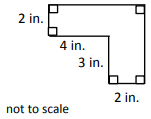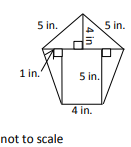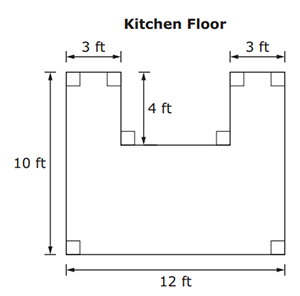Grade 6 Mathematics Secondary Education Mafs.6.g.1.1 Answers Geometry
Find the area of right triangles, other triangles, special quadrilaterals, and polygons by composing into rectangles or decomposing into triangles and other shapes; apply these techniques in the context of solving real-world and mathematical problems.
General Information
Subject Area: Mathematics
Grade: 6
Domain-Subdomain: Geometry
Cluster: Level 2: Basic Application of Skills & Concepts
Date Adopted or Revised: 02/14
Date of Last Rating: 02/14
Status: State Board Approved
Test Item Specifications
- Assessment Limits :
Numbers in items must be nonnegative rational numbers. Limit shapes to those that can be decomposed or composed into rectangles and/or right triangles. - Calculator :
No
- Context :
Allowable
Sample Test Items (3)
- Test Item #: Sample Item 1
- Question:
A shape is shown.

What is the area, in square inches, of the shape?
- Difficulty: N/A
- Type: EE: Equation Editor
- Test Item #: Sample Item 2
- Question:
A pentagon is shown.

What is the area, in square inches, of the pentagon?
- Difficulty: N/A
- Type: EE: Equation Editor
- Test Item #: Sample Item 3
- Question:
Mr. Hilton is buying new tile for his kitchen floor. The dimensions, in feet (ft), of the kitchen floor are shown.

What is the area, in square feet, of Mr. Hilton's kitchen floor?
- Difficulty: N/A
- Type: EE: Equation Editor
Related Access Points
Alternate version of this benchmark for students with significant cognitive disabilities.
MAFS.6.G.1.AP.1a: Compose rectangles to find areas of right triangles using graph paper.
MAFS.6.G.1.AP.1b: Decompose complex shapes (polygon, trapezoid, and pentagon) into simple shapes (rectangles, squares, triangles) to measure area.
Related Resources
Vetted resources educators can use to teach the concepts and skills in this benchmark.
STEM Lessons - Model Eliciting Activity
Building a Tree House:
This MEA will have students determining the safest and most cost effective material to use when building a tree house.They will do this by calculating surface area and determining cost.
Model Eliciting Activities, MEAs, are open-ended, interdisciplinary problem-solving activities that are meant to reveal students' thinking about the concepts embedded in realistic situations. Click here to learn more about MEAs and how they can transform your classroom.
Profit Plaza:
This lesson requires students to use mathematical data and logic/reasoning to place vendors into retail spaces in a shopping plaza. Students will first rank five vendor types on their profitability (based on average sales and average overhead/upkeep costs), then place the vendor types into the 11-13 retail spaces. They are also required to find the area of each space and calculate the total leasing charges. The plans for the plaza are given on a coordinate plane, so students will need to find the lengths of horizontal and vertical line segments (using the coordinates of the endpoints) to calculate the areas of the rectangular and composite spaces.
Model Eliciting Activities, MEAs, are open-ended, interdisciplinary problem-solving activities that are meant to reveal students' thinking about the concepts embedded in realistic situations. Click here to learn more about MEAs and how they can transform your classroom.
MFAS Formative Assessments
Area of Kite:
Students are asked to find the area of a kite by composing it into rectangles or decomposing it into triangles.
Area of Quadrilaterals:
Students are asked to find the area of a trapezoid and a parallelogram by composing or decomposing into triangles and rectangles.
Lost Key:
Students are asked to find the area of a composite plane figure.
Swimming Pool Walkway:
Students are asked to solve a problem involving finding the area of a composite plane figure.
Student Resources
Vetted resources students can use to learn the concepts and skills in this benchmark.
Problem-Solving Tasks
Base and Height:
Students are asked to determine and illustrate all possible descriptions for the base and height of a given triangle.
Type: Problem-Solving Task
Painting a Barn:
Students are asked to use the given information to determine the cost of painting a barn.
Type: Problem-Solving Task
Student Center Activity
Edcite: Mathematics Grade 6:
Students can practice answering mathematics questions on a variety of topics. With an account, students can save their work and send it to their teacher when complete.
Type: Student Center Activity
Tutorials
Finding Area by Decomposing a Shape:
This tutorial demonstrates how the area of an irregular geometric shape may be determined by decomposition to smaller familiar shapes.
Type: Tutorial
Area of a Trapezoid:
A trapezoid is a type of quadrilateral with one set of parallel sides. Here we explain how to find its area.
Type: Tutorial
Area of Triangle on a Grid:
We will be able to find the area of a triangle in a coordinate grid. The formula for the area of a triangle is given in this tutorial.
Type: Tutorial
Perimeter and Area:
Students will learn the basics of finding the perimeter and area of squares and rectangles.
Type: Tutorial
Parent Resources
Vetted resources caregivers can use to help students learn the concepts and skills in this benchmark.
Problem-Solving Tasks
Base and Height:
Students are asked to determine and illustrate all possible descriptions for the base and height of a given triangle.
Type: Problem-Solving Task
Painting a Barn:
Students are asked to use the given information to determine the cost of painting a barn.
Type: Problem-Solving Task
Grade 6 Mathematics Secondary Education Mafs.6.g.1.1 Answers Geometry
Source: https://www.cpalms.org/PreviewStandard/Preview/5455
Posted by: smithaginsons.blogspot.com

0 Response to "Grade 6 Mathematics Secondary Education Mafs.6.g.1.1 Answers Geometry"
Post a Comment